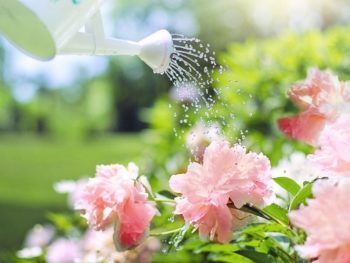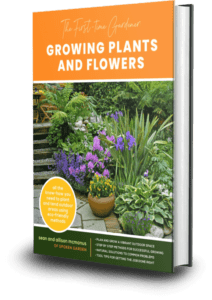Learn the 6 common watering mistakes we see, how they hurt your plants, and how you can avoid them by listening to this podcast episode.
Subscribe on iTunes Stitcher Spotify
Watch us on YouTube

Keep your plants properly watered and their stress levels low by avoiding these 6 common watering mistakes.
Today’s Topic:
6 Common Watering Mistakes and How You Can Avoid Them
In this podcast, you’ll learn what 6 common watering mistakes we see all the time, what to look for, and how to avoid them in your garden.
What You’ll Learn:
- What 6 common watering mistakes we see all time.
- What signs to look for on your garden plants to identify if you are making any of these 6 mistakes.
- How to avoid making these mistakes in your garden.
- Resources and links for more information.
Resources:
Some of the resources and products below may be affiliate links, meaning we might get paid a commission (at no extra cost to you) if you use that link to make a purchase.
- DRAMM Watering Tips freebie
- What is a Garden Watering Wand and Why You Should Use One – DIY Garden Minute Ep. 146
- Personalize Your Watering Needs: An Interview with Jessica Reinhardt from Dramm Corporation – Ep. 47
- Right Plant, Right Place – DIY Garden Minute podcast ep. 134
- Stop Stressing About Planting Mistakes. Use These Proper Planting Techniques (and Hacks) Instead – Ep. 52
6 Common Watering Mistakes To Avoid
In this podcast, you will learn the 6 common watering mistakes we see all the time. After listening to this podcast, you will know what to look for and how to avoid each of these mistakes.
The 6 common watering mistakes we see are:
-
Watering Overhead/ watering the plants leaves
- What to look for: dripping water off leaves, stems, and flowers.
- Why this is bad: water is mainly absorbed through plants roots so watering leaves and tops of plants is inefficient. Also, if a plant has it’s leaves and flowers repeatedly watered without drying off, this can create a great place for pests to make a home, like bacteria or fungus, and even insects. This can be especially true for plants that didn’t evolve under these conditions, which is most garden plants . Examples of plants that don’t like constantly wet leaves or stems are Geraniums, Galdiolus and Dahlias, different softer-leaved Rhodies and Azaleas, and many others.
- How to avoid this problem: water the soil areas around the base of plants and where their roots should be growing, and avoid watering plant leaves, stems, or flowers. Setting up soaker-hoses or a drip system in your gardens where the piping is laying over or even under the soil is more efficient and you get the water right where it needs to go, around and over plant roots.
-
Too high of water pressure
- What to look for: moved or displaced soil around plant, damage to leaves and flowers
- Why this is bad: displacing soil can destabilize plants where they can fall over or be knocked over easily. It also can change drainage around plants and possibly your whole garden, if over time. Your plants can become stressed where they can be more susceptible to insects and diseases.
- How to avoid this problem: Use a low water pressure that won’t move soil when watering. The more similar your watering is to natural rainfall, the better.
-
Under watering plants
- What to look for: Wilting or drooping leaves and stems, and possibly leaf browning.
- Why this is bad: this is stressful to any plant and can stunt and hurt future growth. If left unwatered too long, whole parts of a plant or the entire plant can die.
- How to avoid this problem: Know your plants watering needs, monitor them well, and water plants on a regular schedule with automated systems.
-
Overwatering plants
- What to look for: similar to under watering, you can see drooping or wilting leaves. Also, continuously wet soil that never really dries out. Also, look for rotting roots, browning or yellowing leaves that can fall off.
- Why this is bad: The plants roots cannot breath, (yes, plants roots actually breath) and under these conditions they can’t take up all the water that is around them, so they can drown. Can lead to rotting of the plants roots and secondary damage due to different diseases a plant is susceptible to, along with possible insects.
- How to avoid this problem: just like when underwatering plants, know your plants watering needs and monitor them on a regular basis. Also visually and touch the soil to check for how wet it is. A regular watering schedule on an automated system can help, too.
-
Different plants get the same amount of water that have completely different watering needs
- What to look for: if plants are being over or under watered, like we just discussed.
- Why this is bad: If you group plants together with different water needs you will a combination of over watered and under watered plants all the time. It will be a continuous battle to keep plants healthy and over time either the overwatered or underwatered plants will suffer enough that they will die. Either quickly over this summer or a slower demise into next year, they will die. Then you have wasted your time, efforts, and money, not to mention stressing about these plants. Avoid it this.
- How to avoid this problem: You should group together plants when planting that have the same or as similar water needs. This can be tracked back to your planning and design of your garden, but also if you already have an established garden and certain areas with drought-tolerant plants in full sun, or shade loving plants that still like being on the drier soil end, then take that into account when adding and choosing plants for these specific areas for your garden. We covered this in a previous podcast episode, #49, where we talked about not just your Garden’s needs or your needs, but also your plants’ needs. Listen to that episode to get more in depth on this topic of meeting your plants’ needs.
-
Time of day to water – Scenario: you water your plants during the warmest and hottest time of the day
- What to look for: watch the time of day you are watering your plants. If during the middle of the day or the hottest time of day, then change your watering time.
- Why this is bad: You have to water more and longer during the hottest time of the day because the water is evaporating from the plant the soil around the plant roots at a faster rate. This can also lead to you eventually under watering your plants ultimately leading to drought conditions and worse. Watering during the hottest time of day is inefficient. Also, if certain more tender tissued plants are in direct sunlight and you water any leaves, those leaves can bake in the sun with water on them.
- How to avoid this problem: Water either during the very early morning at or just before dawn, or during the late afternoon or early evening. You can use a simple or complex watering timer that could have a soil moisture sensor so that your plants get regular watering, but not over watered.
If you first need to find the right location in your garden for your new plants, click here to understand “Right Plant, Right Place”.
And, if you have any plant watering questions, please email us and let us know.
Tools and Supplies to Help You Water
- 16 inch Dramm Rain Wand
- 30 inch Dramm Rain Wand
- Garden Hose Adjustable Nozzle
- Garden Hose – multicolored options
- Hose Gaskets
Thanks for Listening!!!
That’s all for this podcast episode! Find other beginning garden topics on our Podcast Page by clicking here or go to SpokenGarden.com and click on the “Listen” tab.
Also find us and subscribe on your favorite podcast platform and smart speaker so you don’t miss any future episodes!
Share Your Thoughts:
- Leave a note in the comment section below.
- Email us at Seanandallison@eseospace.dev
- Follow us on Instagram, Twitter, Facebook, or Pinterest.
To Help Out The Show:
- Share our show with your gardening friends.
- Leave a review on iTunes. Your ratings and reviews really help us out!
- Subscribe on iTunes or Spotify.
- Watch us on our Spoken Garden YouTube channel.
*Spoken Garden is a participant in the Amazon Services LLC Associates Program, an affiliate advertising program designed to provide a means for sites to earn advertising fees by advertising and linking to Amazon.com.







